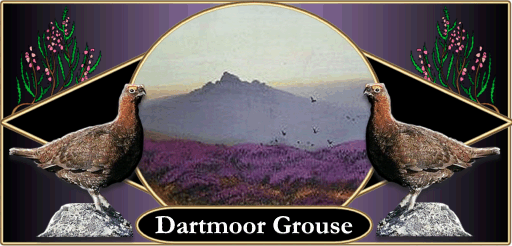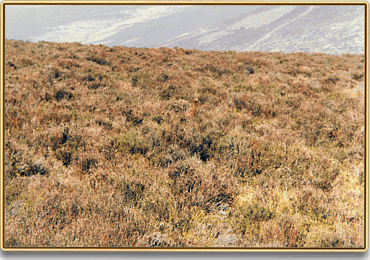
Occasionally you will be walking among the heather on some lonely hillside when suddenly the ground explodes and once your heart has stopped pounding you will see a grouse scudding across the moorside. Alternatively the silence of the heather moor will be broken by a guttural call that seems to be saying, “come out, come out, come out,” then if you are lucky you will spot a red head poking above the heather. By this time the dog has also spotted it and has gone haring off in a useless chase that normally ends up in it sprawling head long into the thick, wiry heather. On Dartmoor, probably the best place to see or hear the grouse is on Hambledon Ridge, nearly every time I have been up there they have been in attendance.

Spot the Grouse – Hameldown
The Red Grouse is probably the only species of grouse that can be seen today on Dartmoor. It is thought that the Red Grouse was not an indigenous bird to the moor and was introduced sometime in the early 1900s for the purpose of shooting. Douglas (St. Leger) Gordon (1933, pp. 56 – 65) relates how in 1912 a hundred pairs of Red Grouse were re-introduced onto various parts of Dartmoor. Eight years later the Duchy stated that the birds had established themselves very well and were predominant on the eastern side of the moor. They also noted that it would probably be another three years before the Prince of Wales held any shooting parties. In 1921 the following appeared in The Times newspaper:
“… The Dartmoor experiment was made some eight years ago, when 100 brace were settled on the moors, where they have bred so well that to-day there is a good number of covies. The Dartmoor grouse has more foxes to contend with than on most preserves, but probably not so many hooded crows or badly fed collies, the most destructive of all moorland vermin. Peregrine Flacons and golden eagles, though not unknown in the West Country are rarer than in the North. Again Dartmoor grouse will not be buried by the heavy snowfalls of Highland springs, when the poor hen is sometimes found on her eggs asphyxiated by the absence of air under the closely packed snow“.
Another hundred pairs were released shortly after but coincided with a large increase in the sheep numbers on the moor. This along with heavy swaling led to the destruction of much of the heather and led to a down turn in the thriving grouse numbers. Eventually the Duchy of Cornwall dropped all plans to hold grouse shoots on Dartmoor as the decline in numbers hardly made them worth while. Since the 1930s the Red Grouse population has declined with annual fluctuations coinciding with the heather loss which again is linked with swaling. In 1979 a complete survey of Dartmoor revealed 57 pairs of which 33 were deemed as breeding pairs. According to the Dartmoor National Park Authority’s website there are presently between 70 and 100 breeding pairs of Red Grouse on the moor. This number is said to be declining and if the frequency in which they update their website is anything to go by the bird is probably now extinct or only to be seen on the label of a whisky bottle. A MOD survey carried out in 2006 on the north moor ranges estimated that there were 27 pairs of Red Grouse on the ranges with a total population of 46 pairs on the entire north moor. This population has been classified as, “relatively stable”, and the survey also notes that Dartmoor is on the southerly edge of the Red Grouse’s European range. It was suggested that on the northern ranges the average density of Red Grouse per square kilometre was 0. 456. with 19 confirmed territories found. To put this into context, it is reckoned that the Red Grouse population for the British Isle is around 154,700 birds. The north moor is considered to have 27 pairs which equated to 0.03% of the national population. If you would like to see the complete MOD survey click – HERE.
So, next time the earth explodes beneath your feet and you see a brown bird whirring off into the distance you will know that you have just met one of the 140 odd Red Grouse that still hang on around the moor. Which statistically means that you have just had a rare sighting.
Bibliography
Crossing, W. 1966 The Dartmoor Worker, David & Charles, Newton Abbot.
Gordon, G. 1933 Dartmoor in all its Moods, Murray, London.
Moor, E. 1837 Climbing and Gallinaceous Birds of Devonshire, Magazine of Natural History.
Rowe, S. 1985 A perambulation of Dartmoor, Devon Books, Exeter.
Smaldon, R. 2005 The Birds of Dartmoor, Isabelline Books, Falmouth.
 Legendary Dartmoor The many aspects past and present of Dartmoor
Legendary Dartmoor The many aspects past and present of Dartmoor

Very interesting article, I saw a single Red Grouse yesterday and a Pair today 5th June 16, both around Cranmere Pool and Yes Tor. My first sighting on the moors in 20 odd years.
Brilliant to see!!